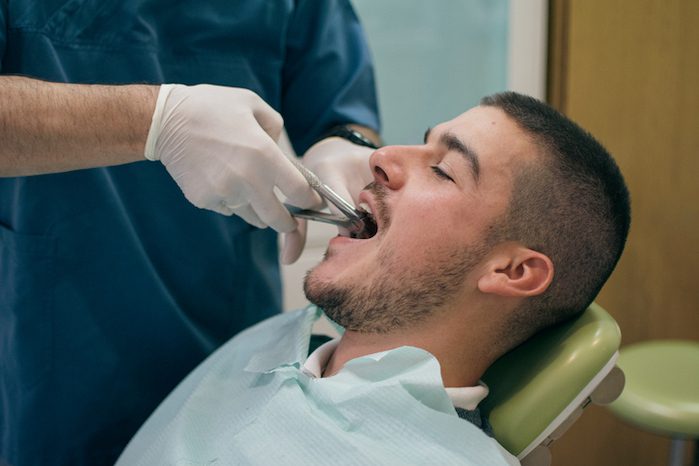A tooth extraction is a common dental procedure that involves removing a tooth from its socket in the bone. While it may sound daunting, extractions improve oral health, prevent further dental complications, or prepare the mouth for dental treatments. Wesley Dental performs tooth extraction treatments in Greenville, TX, as part of our comprehensive general dentistry services.

Types of Tooth Extractions in Greenville, TX
We categorize tooth extractions into two main types: simple and complex.
Simple Extractions
Dentists perform simple extractions on teeth visible in the mouth and easily accessible. This procedure is typically done under local anesthesia, and the dentist uses an elevator to loosen the tooth before removing it with forceps. Simple extractions are relatively quick and straightforward.
Complex Extractions
Complex extractions are more complex procedures performed on teeth that are not easily accessible, such as impacted teeth or teeth that have broken off at the gum line. This type of extraction requires an incision in the gum to access the tooth. Sometimes, the tooth may need to be broken into smaller pieces for removal. Complex extractions are often performed under local anesthesia, sedation, or general anesthesia, depending on the complexity of the procedure and the patient’s comfort level.
Reasons for Tooth Extraction
There are several reasons why you may need a tooth extraction. These include:
Severe Tooth Decay
Extraction may be necessary when tooth decay reaches the inner pulp of a tooth, causing infection or significant damage. In cases where a root canal treatment is insufficient to save the tooth, removal is often the best option to prevent the spread of infection.
Gum Disease
Advanced gum disease, or periodontitis, can cause the teeth to become loose due to the destruction of the supporting bone and tissue. Extraction may be required to maintain oral health when teeth are severely affected and cannot be stabilized.
Overcrowding
Orthodontic treatment often requires teeth removal to create space and allow for proper alignment. Extracting teeth can help address overcrowding, allowing the remaining teeth to be correctly positioned.
Impacted Teeth
Impacted teeth, such as wisdom teeth, do not have enough space to emerge or develop normally. These teeth can become trapped in the jawbone or gums, leading to pain, infection, and damage to adjacent teeth. We often extract impacted teeth to prevent complications.
Trauma
Teeth that are severely damaged due to trauma or injury may need to be extracted if they cannot be repaired with restorative treatments like crowns or bridges.
Preparation for Dentures
In some cases, extracting one or more teeth may be necessary to prepare the mouth for partial or complete dentures. This ensures a better fit and improves the functionality of the dentures.
The Tooth Extraction Procedure
Understanding what happens during a tooth extraction helps reduce anxiety and prepare you for the procedure.
Administration of Anesthesia
Before the extraction begins, your dentist will administer anesthesia to ensure you are comfortable and pain-free. The type of anesthesia used depends on the complexity of the extraction and your level of anxiety. Options include:
- Local Anesthesia: Numbs the area around the tooth.
- Sedation Anesthesia: Helps you relax and reduces anxiety. You may remain conscious but feel drowsy.
- General Anesthesia: Renders you completely unconscious during the procedure.
Extraction Process
For a simple extraction, the dentist will:
- Use an elevator to loosen the tooth.
- Use forceps to grasp the tooth and gently rock it back and forth to break the ligaments holding it in place.
- Remove the tooth from the socket.
For a surgical extraction, the process may involve:
- Making an incision in the gum to access the tooth.
- Removing bone around the tooth if necessary.
- Cutting the tooth into smaller pieces if it is difficult to remove in one piece.
- Extracting the tooth.
- Stitching the incision site to promote healing.
Tooth Extraction Aftercare
Following the dentist’s instructions carefully immediately after the tooth extraction helps minimize potential complications. One of the first things to do is apply gauze to the extraction site to help stop bleeding. You willexperience some bleeding for a few hours after the procedure, but if the bleeding persists, contact our dentist.
After the bleeding stops, do not touch the extraction site with your tongue or fingers. This can help prevent infection and promote healing.
Pain and discomfort are common after a tooth extraction, and the dentist may prescribe pain medication to help manage it. It is important to take the medication as prescribed and avoid aspirin, because it can increase the risk of bleeding.
Rest and avoid strenuous activities in the first 24 hours after the extraction. This can help promote healing and reduce the risk of complications. Also, avoid smoking and drinking through a straw, as these activities can dislodge the blood clot that forms in the extraction site and lead to a painful condition called dry socket.
In the first few days after the extraction, stick to soft foods like yogurt, soup, and mashed potatoes to avoid putting unnecessary pressure on the extraction site. Stay hydrated by drinking plenty of water, but avoid hot drinks and alcohol, as these can interfere with healing.
Proper oral hygiene is essential in the aftercare process. While you should continue to brush and floss, you should also avoid the extraction site to prevent infection. The dentist may also recommend a salt water rinse to help keep the extraction site clean and promote healing.
Swelling is also a common side effect of tooth extraction, and the dentist may recommend applying an ice pack to the affected area to help reduce it. For the first 24 hours after the extraction, apply the ice pack for 20 minutes on and 20 minutes off.
In most cases, the extraction site will heal within a few weeks, but it is important to contact the dentist if any of the following symptoms occur:
- Excessive bleeding
- Severe pain that is not relieved by medication
- Persistent swelling
- Pus or discharge from the extraction site
- Fever
Tooth Extraction FAQs
Learn more about tooth extraction treatment in our Greenville, TX office with answers to these common questions:
How do I know if I need a root canal or tooth extraction?
Knowing whether you need a root canal or a tooth extraction depends on the condition of your tooth. A root canal is typically the best option if your tooth is badly damaged or infected but can still be saved. During a root canal, your dentist removes the infected tissue from inside the tooth, cleans it, and seals it to prevent future problems. A tooth extraction is often necessary if the tooth is too damaged to be saved or causes other issues.
How long does it take to recover from a tooth extraction?
Recovering from your tooth extraction in our Greenville, TX, office can take 1 to 2 weeks. During the first 24 hours, some swelling and discomfort are normal. Apply an ice pack to help reduce swelling.
Over the next 2 to 3 days, the swelling will decrease. You should still avoid heavy physical activity during this time. After the first week, the extraction site will begin to close, and soft tissues will start to heal.
Most people feel back to normal after two weeks. Our dentist may remove any stitches used (if not dissolvable) at a follow-up appointment.
When can I eat after a tooth extraction?
Stick to liquids like water or clear broths immediately after your tooth extraction in our Greenville, TX, office. Do not drink through a straw, as the suction can dislodge the blood clot. Avoid hot beverages like coffee or tea, as they can also affect the clot and slow healing.
After the first 24 hours, eat soft foods like yogurt, applesauce, mashed potatoes, or smoothies. These are gentle on your mouth and won’t irritate the extraction site.
After the first 24 to 48 hours, add more solid foods as you feel comfortable. Do not chew on the side where the tooth was removed. Most people can return to a normal diet about a week after the extraction.
When can I get dental implants after a tooth extraction?
If our dentist determines that your gums need some time to heal, you may need to wait about 4 to 8 weeks after the extraction. This waiting period allows your gums and any inflammation to settle before the implant placement.
If the tooth extraction site needs more time to heal, we may place implants 3 to 6 months after the extraction. This ensures the area is strong and healthy enough to support the implant.
Several factors can affect timing, including your bone and gum health. We can provide gum disease treatment and bone grafting before we place implants.
What happens if I have dry socket?
A dry socket can happen if the blood clot that protects the area where the tooth was removed doesn’t form properly or gets dislodged. This leaves the underlying bone and nerves exposed.
Signs of dry socket include:
- Severe pain a few days after the extraction
- Pain that radiates to your ear, eye, or neck on the same side as the extraction
- Unpleasant taste or smell in your mouth
If you think you have a dry socket, contact us and we will provide over-the-counter or prescribed medications to help manage the discomfort.
Can a dentist remove baby teeth?
Yes, a dentist can remove baby teeth when it’s necessary. While baby teeth usually fall out on their own as adult teeth come in, a dentist may need to step in in several cases:
- Severe Cavities or Damage
- Delayed Loss of Baby Teeth
- Crowding Issues
- Infection
Our dentist always ensures your child feels comfortable if we need to remove baby teeth.
Can I have a tooth extraction if I’m pregnant?
The second trimester, from 13 to 26 weeks, is generally the best time for dental treatments, including extractions. By this time, your baby’s development is well underway, but you’re not as uncomfortable as you might be in the third trimester.
We will limit X-rays to emergencies and use a lead apron to protect your belly. We will also avoid unnecessary procedures and wait until after delivery for elective treatments.
Talk to our dentist if you’re pregnant and might need a tooth extraction. They’ll help you decide the safest plan for your situation.
Do I need antibiotics before or after a tooth extraction?
In most cases, antibiotics are not required. However, our dentist might recommend them if you have a higher risk of infection or certain medical conditions. We recommend it for patients with heart conditions, bone conditions, or a weakened immune system.
Schedule an Appointment
Do you think you may need a tooth extraction in Greenville, TX? Call our office today at 903-455-2942. You can also schedule a consultation online. Let us know if you have questions about treatment. We’re here to help.
